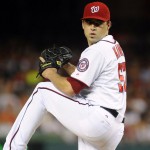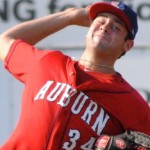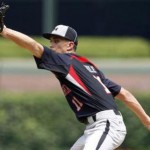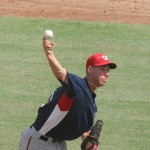
Should this man be on this team? Photo Nats official 2014 via rantsports.com
Despite there being just a scant week until games start … i’m at a loss for content here! Fear not; Mr. Tom Boswell always chats on mondays. Here’s the 3/24/14 edition. This was a monster chat; he took questions for 3.5 hours.
Q: Steven Souza just had a monster spring: Does he need a year at Syracuse or can the Nats use him now?
A: Some guys here love Steven Souza. But he’s an outfielder in a system that already has 5 multi-million dollar outfielders under contract, so he’s not going to break camp with the team. He’s yet to play above AA and could use some seasoning against the near-MLB quality AAA starters. But the Nats didn’t put him on the 40-man roster for the heck of it; you have to think he’s going to feature this year to cover for injuries. He needs some positional flexibility. He’s listed as a third baseman as well; another position we don’t really need any cover for right now. Souza’s problem is that he’s a corner player (LF/RF/3B/1B) on a team with a bunch of them already. So he’s going to have to out-hit a starter to get ABs. Boswell says the same thing I do about not ever playing above AA. Lets see how he does in upstate NY in April.
Q: Is Moore going to lose out on his spot to Peterson?
A: I’ve said it before and I’ll say it again: if a guy already is on the 40-man (Tyler Moore), then the odds of someone who is NOT currently on our (full) 40-man (aka Brock Peterson) beating out an established 40-man player AND dislodging an existing guy off the 40-man roster seems rather remote. Besides, are we even sure Moore is making the 25-man roster at this point? The team already has 5 OFers and needs another guy who can play middle infield, not a guy who can only play a corner. Peterson is a 1B/OF type, much as Moore is. Maybe this is all a precursor towards moving Moore to a team that covets him (Houston). Boswell agrees that Moore is “on the bubble” and then notes that 1B competition after LaRoche is gone will be quite interesting.
[Interlude: someone asked a question about what “Cybermetrics” was. WAR, OPS and WHIP]. Boswell answered it well, getting in his own dig at WAR while he was at it.
Q: Will Lobaton’s throwing arm add to an already-weak area?
A: Maybe; but I’m not sweating the throwing arm mechancis of our once-a-week catcher. I’m more worried about whether Doug Fister is going to be ready for 4/1. Boswell points out that Lobaton’s pitch framing is one of the best … and that if your backup catcher has just one weakness then you’re doing a-ok.
Q: Who’s the 5th starter going to be?
A: Now I’m flip-flopping again, trying to read the tea-leaves, and I’m guessing Taylor Jordan wins it. Ironically it will come down to Tanner Roark‘s flexibility; he’ll head to the pen to be the 7th man and he’ll be happy about it. If Roark were to win the spot, Jordan would be heading to AAA to keep starting and we’d be basically auditioning a kid in the #7 spot (since it seems like Ryan Mattheus is heading to the D/L and Christian Garcia just hasn’t shown he’s got the stuff). I’m ok with this configuration. Boswell uses my previous arguments in saying that Roark deserves it and should have it on merit. We’ll see.
Q: Are you worried about the back of the Nats bullpen with Storen and Soriano’s shaky spring training stats?
A: Yes. Short Sample Sizes, Spring Training stats, blah blah. Soriano has looked awful, Storen not much better. The Bullpen was the weakest part of this team last year and these guys are making too much coin to be just so-so. Problem is, if Soriano blows a bunch of saves and loses the closer job, you might as well just release him because his non-closer splits show what a moper he can be. This is an area to keep an eye on early in the season. Boswell seems to think Soriano will be fine but worries about Storen.
Q: Are the Nationals vindicated in “Shutdown gate” now that Medlen is going in for a second TJ?
A: Phew, I tell you this is a topic I’ve avoided because I want to keep my blood pressure down. But others have certainly chimed in on it (Ted Leavengood at Seamheads.com opined on 3/18/14, as did Thom Loverro in the WashingtonTimes on 3/13/14 and Rantsports.com’s less than cordial website posted its own opinion in the same timeframe). You’ll notice that nowhere in this list are the blowhards at NBCSports’ HardballTalk, some of the more loud and ardent critics of the Nationals 2012 decisions. I wonder why; its like it is in the Newspaper business; nobody notices when you print a retraction of a 20-point headline and bury it on page 12 a few days later; all people remember is the headline.
I think honestly my opinion is in line iwth Loverro’s; we won’t really know if the Strasburg plan or the Medlen plan is really “the best” course of action until both guys are retired. If Strasburg breaks down again, he’ll be in the same place as Medlen. Yes the Nats plan looks better now that we have Strasburg going on opening day and the Braves will be lucky to have Medlen back and healthy this time next year. But it still doens’t prove anything about pitcher mechanics and proclivity to injury (another topic that makes my blood boil; people just spouting off internet theories about biomechanics and presenting themselves as experts on the topic … another topic for another day).
An important note from another questioner on the same topic: all four guys going in for their 2nd TJ surgery this spring (Medlen, Brandon Beachy, Patrick Corbin and Jarrod Parker had their first TJ surgery AFTER both Strasburg and Jordan Zimmermann‘s surgeries. The Nats approach seems to be more and more vindicated by the year.
Boswell doesn’t really bite at the offer to say “I told you so” but offers a link to a paper at NIH on the topic.
Q: Does Espinosa beat out Rendon?
A: No. Yes Espinosa is superior defensively; you don’t need the second coming of Mark Belanger at second. Boswell agrees.
Q: Did Rick Shue really make that big of a difference on this team?
A: Looking at splits both pre- and post- Rick Eckstein/Rick Shue hiring/firing, you would be inclined to say yes. Was this causation or correlation? Who knows. Boswell doesn’t address the second part of a two-part question.
Q: Is the game of baseball headed for disaster thanks to big market dominance, over-emphasis on the teams in the 4 biggest cities and declining popularity?
A: I sense this questioner has a bit of bias. Yes baseball’s ratings are miniscule when compared to Football’s; ask yourself how Football’s ratings would look if there was a game every night. Baseball attendance dwarfs any other sport and is rising. There’s national emphasis on “national” teams sure … but I’ve heard cogent, well put arguments that baseball itself is now basically a regional sport. A strong sport with strong local ties that don’t translate nation-wide. As compared to the NFL, where if the superbowl is Green Bay vs New England people tune in because they associate those teams with their star quarterbacks, not with their geography.
The thing that I worry about is the incredible revenue disparities we’re starting to see. I do believe that the RSN monies that large market teams are pulling in will eventually give way to some sort of small-market owner revolt as the playoffs become the same teams year after year. Sort of like what we see in European Soccer leagues. Nobody wants to see that.
Boswell notes some stats about attendance, calls the game booming and also repeats my “regional points.”
Q: How important at the two early-season series versus Atlanta (April 4-6 at home and then April 11-13 away)?
A: I’d like to be a cynic and say something pithy like, “a game on April 5th counts the same in the standings as a game on September 30th.” But in this case, I think a new manager, a weakened rival and a team that got its *ss handed to them last year by Atlanta will want to make a statement. It could be damaging if the Braves somehow come in here and take 2 of 3. Boswell does talk about the opportunity to put pressure on the Braves early.
Q: Is this the year Strasburg puts it all together?
A: It seems like it; he’s in the same place Zimmermann was in 2013 in terms of surgery recovery; I’d love to see him win 20 games. Boswell drinks the kool-aid and then points out the excellent Adam Kilgore piece in the WP a few days ago on Strasburg; its worth a read.
Q: Who do you think has the most upside between Brian Goodwin, Eury Perez and Michael Taylor? Are the Nats still high on Destin Hood?
A: A prospect question! I’d go Goodwin, Taylor then Perez at this point. But if Goodwin plateaus again this summer Taylor will surpass him. I think Perez has peaked as a late-innings defensive replacement/pinch runner at this point and may be trade-able/DFA able sooner than later. Hood’s time with the organization is running out; he’s entering his 7th minor league season after hitting just .224 with no power in AA last year. I’m thinking he’ll repeat and then hit free agency. Too bad. Boswell doesn’t sound like he likes any of these guys.
Q: Between the Morse trade (Cole, Krol, Treinen), the Guzman trade (Roark), and the Capps trade (Ramos), plus a few others, it seems like the Nats have made some really good trades. Umm, please tell me that the people who scouted these players before any of us had heard of them are well compensated.
A: Yeah, the Nats pro scouting squad has definitely done some great work as of late. Boswell notes that scouts are not paid a ton … but that the Nats raided other teams for quality guys by giving them more respect and input in this org.
Q: Every year the number of pitchers requiring Tommy John surgery seems to be higher than the year before. It has to be clear at this point that the innings limit (alone) is not the answer. When does baseball finally figure this out?
A: Well, what’s the answer then? You can look at literally every pitcher and find a fault or two with his mechanics; this guy has the “inverted W,” this guy subluxes his shoulder, this guy’s arm isn’t in the right position when he lands, this guy’s arm is too high, this guy’s arm is too low. Nobody can define what “perfect mechanics” are. I started pulling up video/images of the career MLB leaders of innings pitched and, guess what, those guys don’t have perfect mechanics either. Don Sutton? 7th all-time in baseball IP and basically 2nd if you take out knuckleballers and dead-ball guys … and he has a perfect inverted-W in his motion.
What is the answer? I wish I knew; i’d be the most in-demand pitching consultant on the planet. When fully 1/3rd of major league pitchers have had Tommy John surgery, and that numbers seems to be rising, maybe the answer is found by looking at the evolving role of pitchers. Velocity is king now: 30 years ago if someone threw 90 it was special; now its mediocre. Relievers especially; think about how power arms in the bullpen are coveted now. Is it possible that the answer to all these arm issues is simply that guys are just trying to throw too hard these days? That’s not much of an answer though. We can talk about youth development, over-throwing as kids, AAU/travel leagues and 10year olds going from playing 18-20 little league games to 45 travel-league games a year. But I’m not sure that’s entirely it; baseball recruits from the Dominican Republic basically did nothing for years except play sand-lot baseball from sun-up to sun-down and that doesn’t seem to affect their longer term injuries….
Or does it? I wonder if there’s any correlation to the “nature” of a players youth development versus future injury? American system versus Japanese versus a developing latino country like Venezuela/Puerto Rico or the D.R.? Excellent post topic.
Boswell totally punts on the question; maybe since there’s no real answer.
Q: Given what Souza has been doing lately, should we focus less on “age appropriateness” in the minors?
A: No. I think Souza is the exception, not the rule. If you’re in your mid 20s and you’ve yet to succeed beyond high A … that’s pretty indicative of what your ceiling may be. Simple as that. Boswell points out that Roark is 27 and is a classic “late bloomer.”
Q: Does the news that Scherzer and Desmond declined long-term deals portend eventual trouble for the likes of Strasburg and Harper?
A: No; i think those guys were already going to be trouble. What’s the common denominator here? Two words: Scott Boras. Scherzer == Boras client. Strasburg? same. Harper? Same. Desmond isn’t a Boras client but he’s gotta be looking at some of the monster SS deals out there and saying, I’m going to hit the FA market to see what’s out there. Can’t blame him. The 2016 off-season is going to be an interesting one for this team. Boswell mentions the Elvis Andrus contract, as I have many times, as a game-changer for Desmond.







